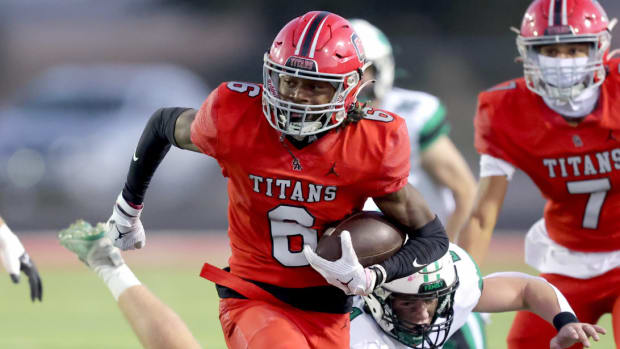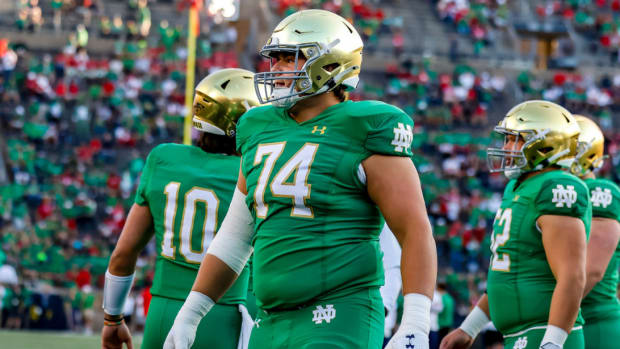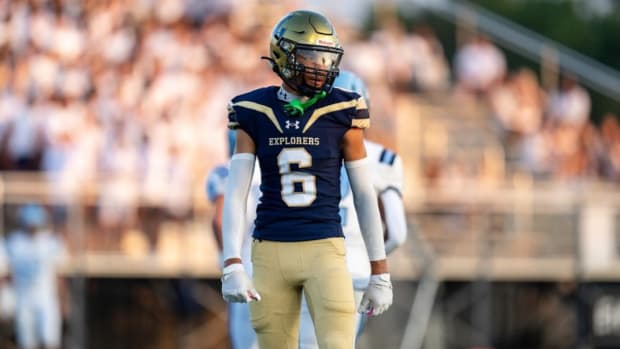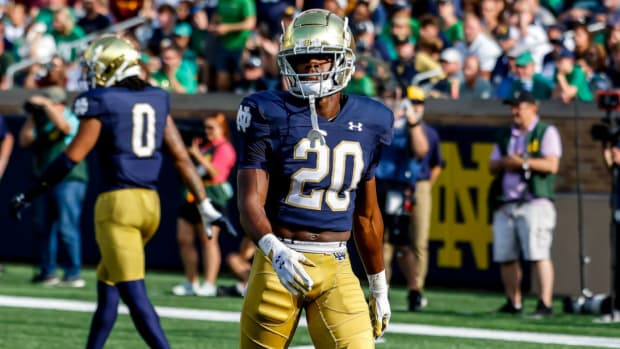Bowl Prep: Breaking Down The Iowa State Offense
Notre Dame and Iowa State square off Saturday in the Camping World Bowl. The Fighting Irish defense will have its hands full against a Cyclone offense that ranks 18th nationally in offensive efficiency according to the Fremeau Efficiency Index.
With National Signing Day in the rearview mirror it’s time to focus on the upcoming bowl game, and we begin by breaking down the Iowa State offense.
OFFENSIVE OVERVIEW
To see how Iowa State stacks up statistically against the Notre Dame defense CLICK HERE.
To see how Iowa State stacks up statistically against the Notre Dame defense CLICK HERE.
Oklahoma was the only Big 12 offense to have better passing numbers than Iowa State. The Cyclones use the run game more as a complement to the pass game, but if defense’s don’t respect it you will see Iowa State go to it more frequently. Iowa State will also go to the run game to provide the offense with a bit of a spark when team’s overplay the pass game, which we saw early in the third quarter against Oklahoma
Iowa State runs a traditional spread offense. It will use a variety of formations and personnel groupings, going three wide receivers on one series and then coming back with two or three tight ends on the next.
The Cyclones are not an up-tempo offense in their base philosophy, but there are times within a series and within a game where you will see them speed things up in an attempt to catch the defense off balance.
Iowa State won’t call a lot of trick plays, but if they see the defense over-committing they will run some kind of trick play. I’ve seen them run a reverse pass and also a lateral to a back that was then thrown downfield.
RUN GAME: Iowa State will use a number of different run game looks, but the main concepts I’ve seen are the inside zone, outside zone/stretch and a couple of sweep/pitch plays. You will also see a number of jet sweeps, with some being hand offs and others being quick flips that are passes in the stat sheet.
Breaking down the film it seems Iowa State will make a lot of run checks. What this means is the quarterback will check into a run play if it has good numbers in the box. The sideline coaches will also make checks into the run game based on how the defense lines up.
PASS GAME: Iowa State spends much of its pass game attacking the short to intermediate zones in a variety of ways. The Cyclones will RPO’s throughout the game, but there is variety to how it utilizes this philosophy. There are quick game routes ISU will throw off the RPO, they will use it to beat the blitz and they will also take downfield shots off the RPO. The main downfield route I’ve seen ISU use in the RPO is a quick backside post route that looks to hit behind the linebackers but in front of the safeties.
The Cyclones attack the middle of the field quite a bit, going after teams with a volume of crossing routes, middle of the field option routes and drag routes. In order to accomplish this the ISU offense will utilize a high volume of high-low concepts with these various routes, and the quarterback will read the linebackers to determine whether to throw short or attack deeper concepts. Iowa State really likes to use a lot of rub routes over the middle, especially on third-down.
Iowa State doesn’t push the ball vertically much. Just 11-percent of quarterback Brock Purdy’s 446 throws traveled at least 20 yards down the field. Compare that to 15.8-percent for Notre Dame quarterback Ian Book. When Iowa State does go downfield it's usually off a play-action look.
Fifty-five percent of Purdy’s deep throws attacked between the numbers, with Purdy preferring to attack from a few yards outside of the hash to the middle of the field. Purdy completed just nine deep balls outside the numbers this season.
In fact, 61.7-percent of Purdy’s throws that traveled past the line of scrimmage were inside the numbers. Compare that to 53.6-percent of Book’s throws.
Iowa State's pass catchers lack great speed and none of them are overly explosive, but they are well-schooled when it comes to running routes and the pass concepts used create a lot of open players.
#15 BROCK PURDY, QUARTERBACK
2019 Stats: 295 com., 445 att., 66.3%, 3,760 pass yards, 27 TD’s, 9 INT’s, 153.24 efficiency / 265 rush yards, 8 TD’s
The sophomore quarterback earned second-team All-Big 12 honors this season after racking up over 4,000 yards and 35 total touchdowns despite losing running back David Montgomery (3rd Round - Bears) and wide receiver Hakeem Butler (4th Round - Cardinals) from last season’s squad.
Pro Football Focus recently ranked Purdy as the 8th-best pro prospect at quarterback in the bowl games, with Book ranking 35th. The interesting thing about that is Book has a stronger arm, throws a better deep ball and is a better athlete. Purdy is better than Book, of that there is little doubt, but it’s not because of his physical tools.
Purdy is a smart, savvy quarterback that shows excellent poise in the pocket, and for such a young quarterback he has an advanced feel for reading defenses and distributing the football. Iowa State had four pass catchers top 600 yards receiving this season, evidence of Purdy’s willingness to spread the ball around. He has a quick release and is accurate with the football.
Purdy is very good against the blitz, showing the ability to quickly get the ball out behind pressures. He also does a great job moving around in the pocket, keeping his eyes downfield and he can move the chains with his legs. At times Purdy will lock onto routes over the middle, and he’ll take chances over the middle of the field, especially on third-down. This is when he can get in trouble, but it’s also when he makes some of his biggest plays.
The sophomore quarterback played well against the best team’s on ISU’s schedule. He averaged 320.5 yards per game, had a pass efficiency rating of 139.41 and threw nine touchdowns against the four ranked teams Iowa State played this season. Purdy averaged 7.5 yards per attempt and completed 63.7-percent of his throws in those games. Compare that to Book’s numbers, with the Irish quarterback completing just 55.0-percent of his throws against Power 5 opponents in the Top 25, averaging just 169.5 yards, 5.3 yards per attempt and throwing just four touchdowns and producing a passer rating of just 106.32.
#28 BREECE HALL, RUNNING BACK
2019 Stats: 169 carries, 842 yards, 5.0 YPC, 9 TD’s / 19 catches, 207 yards, 10.9 YPC, 1 TD
Hall earned second-team All-Big 12 honors and was named a Freshman All-American this season after racking up 1,049 total yards. Hall got just 18 carries in the first five games of the season, and once he was inserted into a prime role during Iowa State’s Oct. 12 victory at West Virginia he took off. Over the final seven games of the season Hall rushed for 758 yards and caught all 19 of his passes and churned out 207 yards through the air.
Hall is a smooth runner that combines patience and decisiveness. He’s not a home run hitter, but he has excellent feet and balance, which allows him to attack downhill and make plays in space. The freshman has excellent vision and he has a nasty spin move. Hall does a lot of damage on check downs in the pass game, but he can catch the ball on designed routes as well.
#8 DESHAUNTE JONES, WIDE RECEIVER
2019 Stats: 72 catches, 832 yards, 11.6 YPC, 2 TD’s
Jones earned second-team All-Big 12 honors this season, leading Iowa State in receptions and receiving yards. Iowa State will move its receivers around, but Jones does most of his damage from the slot and over the middle of the field. Jones does a good job mixing up his speed off the line and he shows a good feel for working himself open against the zone. He struggles to get a lot of separation against man at times due to his lack of top-end speed, but his route running allows him to be an effective chain mover for the Cyclones. Jones is a tough player that will take punishment if it means securing the catch.
#1 TARIQUE MILTON, WIDE RECEIVER
2019 Stats: 33 catches, 689 yards, 20.9 YPC, 3 TD’s
Milton is the best big-play threat in the Iowa State offense, and he’ll do it in different ways. The 5-10, 183-pound wideout can stretch the field, using sharp route running and above-average speed to get down the field. He’s also a weapon in the play-action game, and Milton is the guy you’ll often see Iowa State look to on vertical play-action routes. The sophomore wideout also shows the ability to make plays after the catch, which we saw against Oklahoma when Milton took a catch behind the line and turned it into a 40-yard touchdown. Milton spends a lot of time on the backside of the formation, but like the rest of the wideouts he’ll move around the formations.
#7 LA’MICHAEL PETTWAY, WIDE RECEIVER
2019 Stats: 51 catches, 622 yards, 12.2 YPC, 6 TD’s
Pettway is the biggest and most physical pass catcher in the Cyclone offense. At 6-2 and 223 pounds, Pettway has size that he can use to out-position players for the football, and he uses his strength to get separation on sideline routes. He spends most of the game to the outside, although he plays more to the strong side of the formation (field) than he does in the boundary. Pettway is a chain mover but can also work the middle of the field.
#88 CHARLIE KOLAR, TIGHT END
2019 Stats: 48 catches, 675 yards, 14.1 YPC, 7 TD’s
The sophomore tight end earned first-team All-Big 12 honors this season after racking up impressive numbers in the pass game. Kolar’s seven receiving touchdowns were fourth in the nation among tight ends, his 675 yards were fifth month among the nation’s tight ends and his 48 catches were eighth nationally among tight ends. Kolar isn’t the kind of athlete that Notre Dame tight end Cole Kmet is, and he lacks Kmet’s girth. He struggles to get separation at times, but he has impressive balance and body control, and he does an excellent job making contested grabs. Iowa State’s coaches do a good job moving him around the offense to get him in good matchups, and he’s used quite often on the rub routes and high-low concepts to get him open over the middle.
OFFENSIVE LINE
Iowa State has a well-coached offensive line that competes, which allows the unit to be effective. Despite averaging 301.6 pounds across the board, the Iowa State offense isn’t overly powerful and can struggle at all spots against top-level players.
Left tackle Julian Good-Jones (6-5, 308) earned first-team All-Big 12 honors, and according to Pro Football Focus he did not allow a sack this season. Good-Jones has good length, but he can struggle with speed and standout Baylor end James Lynch dominated his matchup against Good-Jones. He was credited with 27 pressures allowed this season.
Right guard Josh Knipfel (6-5, 305) is the best interior blocker for the Cyclones, but right tackle Bryce Meeker (6-6, 305) was the highest graded blocker according to Pro Football Focus.
Bowl Prep: Iowa State Cyclones
Stacking Up: Notre Dame Offense vs. Iowa State Defense
Stacking Up: Notre Dame Defense vs. Iowa State Offense
Notre Dame vs. Iowa State: Recruiting Comparison
Follow me on Twitter: @CoachD178
Visit our Facebook page at: https://www.facebook.com/IrishMaven/





